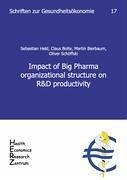Why is R+D productivity in Big Pharma decreasing despite an unprecedented corporate research investment? A selection of established research-based pharmaceutical companies were assessed in terms of their organizational R&D structure and how this correlates with their research productivity, assuming successful innovation not only depends on individual scientists but also on the way you organize them in large corporations. This hypothesis was investigated by collating data from Big Pharmäs annual business reports, evidence published in professional journals and information provided by the FDA and EMEA. Subsequently, this information was evaluated with the balanced scorecard methodology: different organizational models in ranking order of their R&D productivity. Our analysis describes pros and cons of different types of organizational R&D models for large multinational pharma companies, and clearly reveals one model as the most productive organizational structure for Big Pharma. Interestingly, only three out of eight companies selected for this evaluation had adopted this R&D model. Are they going to lead the pack moving forward?








